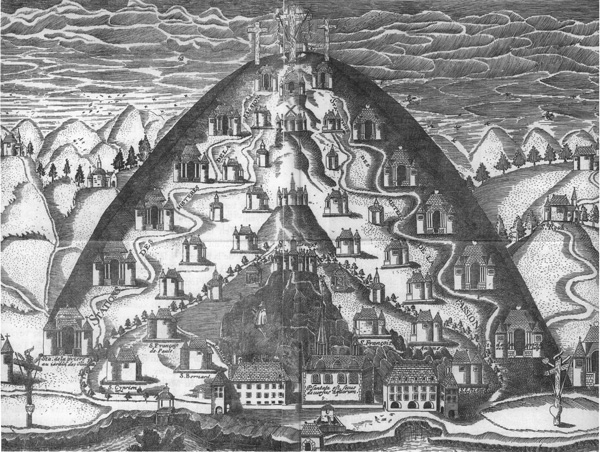The Calvary of Betharram (2)
The first Calvary of the XVIIth century
1620. In Bearn the revolutionary spirit didn’t give up. Despite the edict from Fontainebleau the Protestants refused to restore to the Catholics the properties which had been stolen. Louis XIII consequently set out for Bearn. In 1621 the troops belonging to the Duke of Epernon restored a kind of Peace.
The Bearn skies were still somewhat clouded when Betharram greeted the saintly priest, Hubert Charpentier. Introduced by Jean de Salette, Bishop of Lescar, for the purpose of restoring the pilgrimage to Betharram, H. Charpentier took a long time to make up his mind, according to the historian Marca; to wander into such dangerous rocks didn’t inspire him at all. Father H. Lassalle explains: “It is difficult for us today to imagine what the wild countryside around Betharram was like then”. For years H. Charpentier had shown his devotion to the mystery of the Cross. By 1622 he decided to join the cult of the Son with that of the Mother and to erect a cross on the top of the hill. “Furthermore he was being invited by a sign from heaven: the miracle of the cross which had been erected in September 1616. Consequently, H. Charpentier wanted to make quite sure of the truth of the facts then reported. The five peasant-witnesses had to undergo further questionings; everything was tested: sincerity, health, and morality of the peasants; the police put the patience of these good people on trial until finally they had to admit that they were Béarnaise folk as far removed from falsehood as they were from malice. Thus encouraged H. Charpentier have three tall crosses erected on the top of the hill on the spot where the miracle had taken place in September. This was the first Calvary of Betharram and it was inaugurated on Good Friday 1623. On the following 8th September it was to be the object of solemn celebrations. On that day the hill was threatened by a thunder storm which eventually receded. The pilgrims didn’t fail to see there another sign of approval from heaven.

But H. Charpentier had imagined an even greater project, equal to his devotions. Paintings or statues were going to show the main scenes of Christ’s life before his Resurrection. Small chapels to house these scenes were built along the paths between the chapel and the top of the hill. The plan has come down to us in the shape of a stamp (see picture on the right). However, through lack of funds, neither H. Charpentier nor his immediate successors were able to realise the project. How can we comment on the importance of Charpentier’s undertakings? There is nothing there today; the place has completely changed; the actual buildings didn’t even exist in his day; for three hundred years the rock continued to be eroded and the hill to recede. In 1625 the gift of Louis XIII allowed the construction on the rocks overlooking the chapel, of the Saint Louis Oratory; it will be the 5th station: the Crowning with Thorns. There were no other buildings until reaching the top. One can conclude that the intervening stations would have been signalled by a cross or some other sign. On the esplanade and facing the three crosses the construction of the Sepulchre was begun. It was only finished in 1639 and H. Charpentier had already left Betharram in 1638. Neither the activities of the chaplains not the great devotion by the presence of Calvary escaped the notice of Mgr Jean de Salette who on 9th June 1626 gave Our Lady of Betharram the title of Our Lady of Calvary. In 1661 the year of the consecration of the restored Chapel, there were still only four station-oratories, and the Calvary remained in that state throughout the whole of the 17th century.
Raymond Descomps scj (1916 - 2009)
in «L’Écho de Bétharram»
Document Actions








